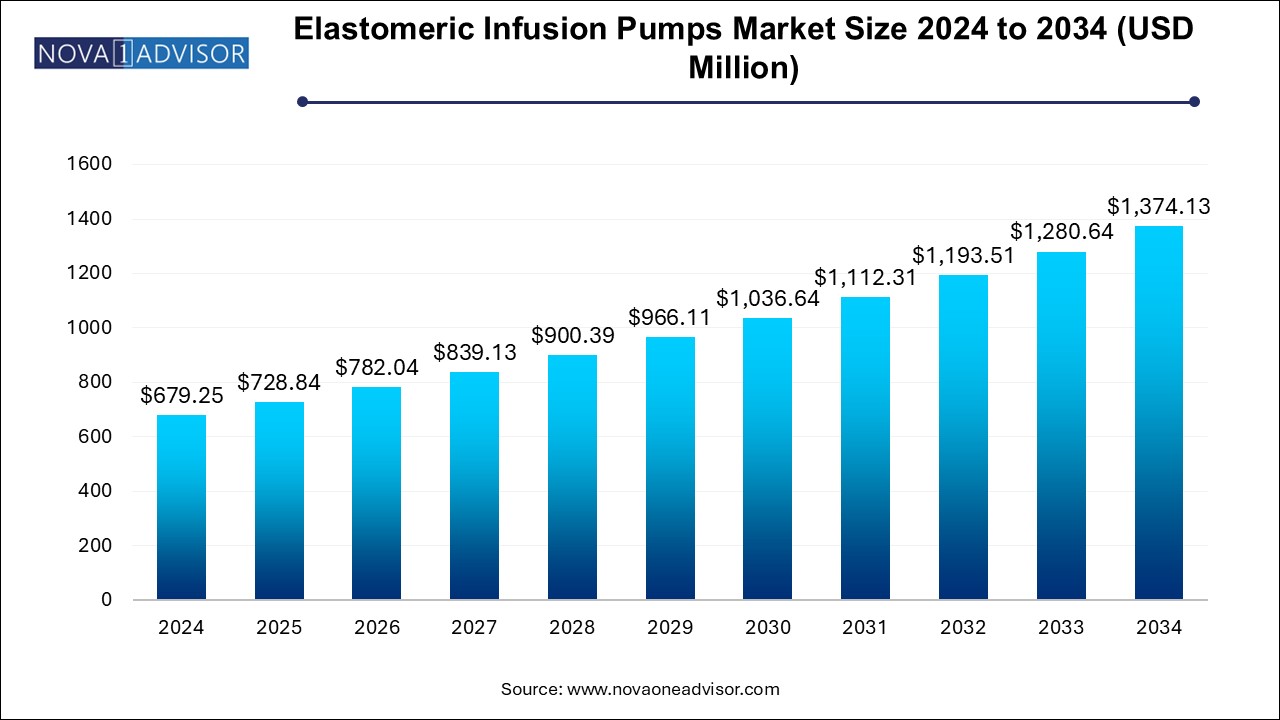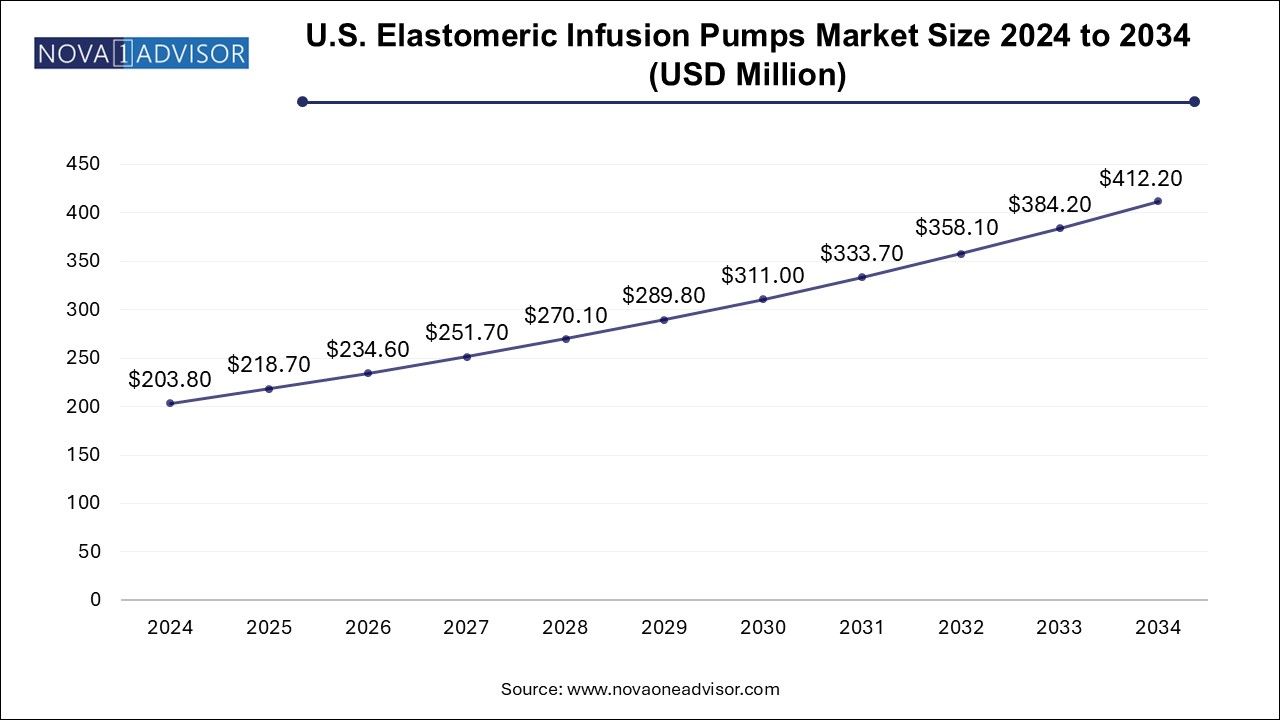The elastomeric infusion pumps market size was exhibited at USD 679.25 million in 2024 and is projected to hit around USD 1374.13 million by 2034, growing at a CAGR of 7.3% during the forecast period 2025 to 2034.

The Elastomeric Infusion Pumps Market has emerged as a significant component of the global drug delivery industry, witnessing consistent growth due to the increasing demand for cost-effective and portable infusion solutions. These pumps, also referred to as balloon pumps, utilize an elastomeric layer to deliver medication at a controlled flow rate, making them suitable for a variety of clinical settings. Unlike electronic infusion pumps, elastomeric pumps require no batteries or electricity, thereby reducing the complexity of usage and operational costs. This makes them highly favorable in both developed and developing regions, particularly in outpatient and homecare environments.
With the rising incidence of chronic diseases such as cancer, postoperative pain, and infectious diseases, the market is increasingly adopting elastomeric infusion pumps for drug administration including chemotherapy agents, analgesics, and antibiotics. Furthermore, the global trend toward ambulatory care and home-based treatment models further supports the growth of the market. The affordability, simplicity, and portability of elastomeric pumps give them a competitive edge over traditional infusion systems.
In addition, the increasing emphasis on reducing hospital stays and healthcare costs is encouraging the shift toward outpatient care and home infusion therapies, where elastomeric infusion pumps play a vital role. Technological innovations and strategic partnerships between hospitals and medical device manufacturers are also propelling market expansion. The market is expected to register significant growth over the next decade as healthcare infrastructure evolves and patient preferences change.
The U.S. elastomeric infusion pumps market size is evaluated at USD 203.8 million in 2024 and is projected to be worth around USD 412.2 million by 2034, growing at a CAGR of 6.61% from 2025 to 2034.

North America dominated the global elastomeric infusion pumps market, driven by a well-established healthcare infrastructure, high prevalence of chronic illnesses, and a strong shift toward outpatient care. The United States, in particular, has witnessed widespread adoption of home infusion therapies for cancer, infections, and pain management. Reimbursement support and favorable regulations for home healthcare further contribute to the region’s market dominance. Additionally, continuous innovation and product development by regional companies play a key role in maintaining North America's leading position.
Asia-Pacific is the fastest-growing regional market for elastomeric infusion pumps. Countries such as China, India, and Japan are witnessing rapid healthcare modernization, rising patient awareness, and growing government initiatives to support home-based care. The region’s expanding middle class, increased healthcare spending, and growing burden of chronic diseases such as cancer and diabetes are accelerating the adoption of infusion pumps. The lower cost and simple design of elastomeric pumps make them an attractive option in resource-constrained settings, which further bolsters growth in this region.
| Report Coverage | Details |
| Market Size in 2025 | USD 728.84 Million |
| Market Size by 2034 | USD 1374.13 Million |
| Growth Rate From 2025 to 2034 | CAGR of 7.3% |
| Base Year | 2024 |
| Forecast Period | 2025-2034 |
| Segments Covered | Product, Application, End-use, Region |
| Market Analysis (Terms Used) | Value (US$ Million/Billion) or (Volume/Units) |
| Regional scope | North America; Europe; Asia Pacific; Latin America; MEA |
| Key Companies Profiled | Baxter; Fresenius Kabi AG; B. Braun SE; Ambu A/S; Leventon, S.A.U.; NIPRO; Terumo Corporation; AVNS; Vygon Group; Smiths Group plc |
Market Driver: Rising Prevalence of Chronic Illnesses and Postoperative Pain
One of the primary growth drivers of the elastomeric infusion pumps market is the increasing prevalence of chronic illnesses such as cancer, arthritis, and cardiovascular diseases, coupled with the need for effective postoperative pain management. In modern healthcare systems, effective pain control is a critical aspect of patient care and recovery. Elastomeric infusion pumps, being disposable and non-electronic, serve as a valuable tool for continuous pain management post-surgery, both in hospitals and in-home settings.
For instance, in postoperative environments, patients often require steady, long-term infusion of analgesics. Elastomeric pumps allow controlled delivery of medications like morphine or fentanyl without the need for frequent medical intervention. Similarly, cancer patients undergoing chemotherapy benefit from elastomeric pumps' ability to deliver cytotoxic agents over extended periods, improving treatment adherence and outcomes. As chronic disease cases rise globally, the utility of these devices in pain and symptom management becomes increasingly apparent, thereby fueling market growth.
Market Restraint: Risk of Inaccurate Dosage and Lack of Flow Regulation
Despite their many advantages, elastomeric infusion pumps are often limited by their lack of advanced flow control, which may lead to inconsistent or inaccurate dosage delivery. Unlike electronic infusion pumps, these devices rely on the physical properties of elastomers to maintain pressure and control flow, which can be influenced by external factors like temperature, pressure, and patient movement. This can sometimes result in under-infusion or over-infusion of medication.
Such limitations are particularly critical in settings that require high precision, such as neonatal care or intensive care units. Moreover, without built-in alarms or monitoring features, any malfunction or variation may go unnoticed, potentially compromising patient safety. These concerns have restricted their adoption in complex hospital settings, thereby hindering broader market penetration.
Market Opportunity: Expansion in Emerging Markets and Home Infusion Therapies
The global shift toward home-based care represents a substantial opportunity for the elastomeric infusion pumps market, especially in emerging economies. Countries in Asia-Pacific, Latin America, and Africa are investing heavily in strengthening their primary healthcare systems and infrastructure. As healthcare budgets tighten and populations age, the demand for low-cost, portable, and user-friendly infusion solutions has increased dramatically.
Elastomeric pumps offer a viable solution for administering long-term treatments like antibiotics, antivirals, and chemotherapeutics at home. Companies that focus on local manufacturing, training, and distribution can capitalize on the rising demand in these regions. Moreover, supportive government policies that promote outpatient care and reduce hospital stay durations further enhance the opportunity. With improvements in awareness, training, and distribution, the elastomeric pump market is poised to capture significant market share in these regions.
Continuous Rate Elastomeric Infusion Pumps dominated the product segment due to their widespread usage in post-operative pain management and chemotherapy applications. These pumps provide a constant and controlled drug release rate over a specific duration, which is ideal for many therapeutic protocols. They are commonly used in hospital discharge scenarios, allowing patients to continue receiving medication without frequent returns to the healthcare facility. Their consistent flow and simple design make them favorable in both hospital and home settings, thus driving their dominance in the market.
In contrast, Variable Rate Elastomeric Infusion Pumps are the fastest growing segment as healthcare providers increasingly seek personalized medication delivery solutions. These pumps offer adjustable flow rates, allowing clinicians to customize treatment protocols according to individual patient needs. This flexibility makes them suitable for complex therapeutic applications like palliative care and multi-drug infusion. As patient-centered care becomes a focal point in modern medicine, the demand for versatile infusion devices is expected to push the growth of this segment.
Pain Management dominated the application segment of the elastomeric infusion pumps market. Postoperative pain control, particularly following orthopedic or cardiac surgeries, necessitates the use of continuous drug delivery systems. Elastomeric pumps are preferred for this purpose due to their non-electronic design, ease of use, and portability. They ensure uninterrupted analgesic infusion, enabling quicker recovery and reduced hospital stay durations. These attributes have led to significant adoption in pain management across both inpatient and outpatient settings.
Meanwhile, Chemotherapy is the fastest-growing application segment, driven by the rising global incidence of cancer. As treatment regimens become more complex and long-term, elastomeric pumps provide an effective and patient-friendly means to administer cytotoxic drugs. Home-based infusion chemotherapy is gaining popularity, and these pumps play a central role in enabling this model. Their disposable nature and minimal technical requirements make them ideal for oncological care outside traditional hospital environments.
Hospitals dominated the end-use segment due to the high volume of surgical procedures and in-hospital treatments that require consistent infusion therapy. Hospitals benefit from the use of elastomeric pumps in both preoperative and postoperative care, especially in pain management, infection control, and chemotherapy. With an increasing focus on early discharge and reducing readmission rates, hospitals increasingly use these pumps to support patients during recovery at home, contributing to their dominant share.
On the other hand, Ambulatory Surgical Centers (ASCs) are the fastest-growing end-use due to the rapid growth of day-care surgeries and outpatient procedures. ASCs favor the use of elastomeric pumps for their ease of use, minimal need for monitoring, and compatibility with shorter hospital stays. The global shift toward minimally invasive surgeries and outpatient care makes ASCs a vital growth avenue for elastomeric infusion devices, especially in North America and Europe.
This report forecasts revenue growth at country levels and provides an analysis of the latest industry trends in each of the sub-segments from 2021 to 2034. For this study, Nova one advisor, Inc. has segmented the elastomeric infusion pumps market
By Product
By Application
By End-use
By Regional